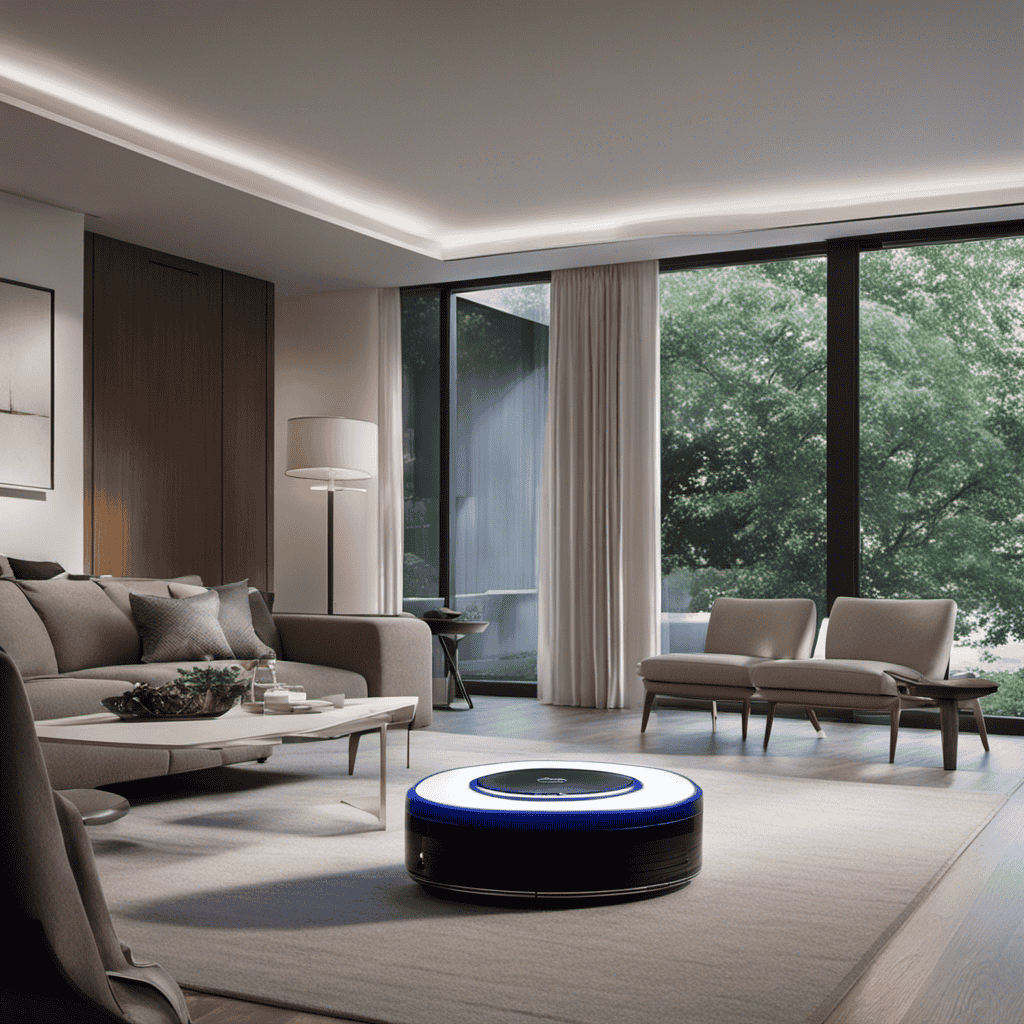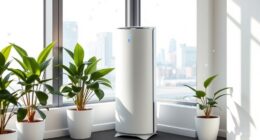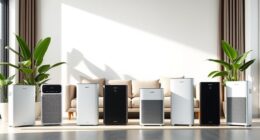If you’re looking to guarantee your outdoor environment stays safe in 2025, I recommend considering top-rated air quality monitors like the AirVisual, Ecowitt, Ambient Weather, and GoveeLife models. These devices offer accurate detection of PM levels, gases, and environmental factors, with features like Wi-Fi connectivity and weatherproof designs. Choosing the right one depends on your specific needs, and staying informed about your air quality is easier with these reliable tools. If you keep exploring, you’ll find even more options that fit your lifestyle.
Key Takeaways
- Look for devices with comprehensive parameter monitoring including PM, gases, temperature, and humidity for thorough air quality assessment.
- Prioritize models with durable, weatherproof designs suitable for outdoor environments and rugged use.
- Ensure compatibility with Wi-Fi or 4G for real-time remote monitoring and alert capabilities.
- Check sensor accuracy, calibration options, and regular maintenance requirements to ensure reliable data over time.
- Consider user-friendly features like easy data export, smart alerts, and clear displays for effective environmental management.
AirVisual Outdoor Air Quality Monitor
If you’re looking for a durable, professional-grade outdoor air quality monitor that provides reliable data over years, the AirVisual Outdoor is an excellent choice. Made in Germany, it features weatherproof housing, modular sensors, and flexible installation options like wall, roof, pole, or portable setups. It measures up to eight parameters, including PM1, PM2.5, PM10, CO2 (optional), temperature, humidity, and atmospheric pressure, with high-accuracy laser sensors. Connectivity options include Wi-Fi, LAN, and 4G, and it integrates seamlessly with the IQAir app. Its sturdy design and real-time data make it ideal for both personal and professional outdoor air quality monitoring.
Best For: outdoor air quality professionals and environmentally conscious individuals seeking durable, accurate, and versatile air monitoring solutions.
Pros:
- Made in Germany with high-quality, weatherproof construction ensuring durability and longevity
- Modular sensor slots allow for customizable measurements, including PM and optional CO2 sensors
- Seamless integration with the IQAir app provides real-time data, alerts, and remote access
Cons:
- Some users report sensor accuracy issues or malfunctions over time
- Outdated charging cable (micro-USB) may require replacement for modern devices
- Lacks advanced air quality metrics such as VOCs or HCHO, limiting comprehensive environmental analysis
Amazon Smart Air Quality Monitor – Know your air, Works with Alexa
Looking to effortlessly monitor your indoor air quality and stay informed at all times? The Amazon Smart Air Quality Monitor makes this easy by tracking five key factors: PM 2.5, VOCs, CO, humidity, and temperature. It provides real-time updates through color-coded LEDs and an intuitive air quality score via the Alexa app. When air quality drops, it sends alerts to your phone or announces them on Echo devices, so you can act quickly. Compatible with Alexa, it integrates with routines to automatically control air purifiers, fans, or dehumidifiers. Setup is straightforward, making it accessible for everyone seeking smarter, healthier indoor environments.
Best For: individuals seeking an easy-to-use, integrated solution to monitor and improve indoor air quality with smart home automation capabilities.
Pros:
- Tracks five key air quality factors including PM 2.5, VOCs, CO, humidity, and temperature for comprehensive monitoring
- Integrates seamlessly with Alexa for real-time alerts and automation routines to control connected devices
- Simple setup certified for Humans, making it accessible even for non-experts
Cons:
- Requires compatible Alexa-enabled devices for full automation features
- May need additional sensors or devices for complete air purification or climate control solutions
- The device’s reliance on app notifications may not suit users preferring solely audible or visual alerts
AirVisual Outdoor Air Quality Monitor
The AirVisual Outdoor Air Quality Monitor stands out for its professional-grade accuracy and durability, making it an excellent choice for both environmental professionals and serious outdoor enthusiasts. Made in Germany, it features modular sensor slots, including two preinstalled PM sensors for reliable PM1, PM2.5, and PM10 measurements, with an optional CO2 sensor. Its weatherproof housing and sturdy construction guarantee long-lasting use in various environments. The device measures up to eight parameters, including AQI, temperature, humidity, and atmospheric pressure, providing real-time data and forecasts. With seamless app integration and flexible installation options, it offers precise, continuous monitoring to keep you informed and safe outdoors.
Best For: environmental professionals and outdoor enthusiasts seeking durable, accurate, and real-time outdoor air quality monitoring.
Pros:
- Professional-grade accuracy with dual preinstalled PM sensors and optional CO2 module
- Weatherproof, sturdy construction suitable for various outdoor environments
- Seamless app integration with real-time data, forecasts, and flexible installation options
Cons:
- Occasional sensor reliability issues and inaccurate readings over time
- Outdated micro-USB charging cable instead of modern USB-C port
- Limited detection of VOCs and additional air quality parameters
Ecowitt WH0290 Air Quality Monitor with PM2.5 Detection
The Ecowitt WH0290 Air Quality Monitor stands out for its portability and wireless operation, making it an ideal choice for anyone who wants real-time PM2.5 data across indoor and outdoor environments. I appreciate its compact size, solar power capability, and easy setup, which means I can monitor air quality anywhere—home, office, or on the go. It displays current and peak PM2.5 levels, along with temperature and humidity, using a clear air quality indicator. Though some users report occasional inaccuracies, its accuracy aligns well with other sensors. Its remote monitoring feature, rechargeable batteries, and affordability make it a versatile option for keeping track of environmental health.
Best For: individuals seeking a portable, easy-to-use air quality monitor for real-time indoor and outdoor PM2.5 data, especially those with health concerns or in areas with pollution or volcanic activity.
Pros:
- Compact, lightweight, and portable for versatile placement indoors or outdoors
- Wireless with rechargeable batteries and solar power for convenient, eco-friendly operation
- Provides real-time PM2.5, temperature, humidity, and peak values with clear air quality indicators
Cons:
- Display lacks backlit illumination, which may affect readability in low-light conditions
- Some users report sensor inaccuracies or malfunctions after extended use
- Battery life can be limited without solar recharge, requiring periodic replacement or charging
Ambient Weather PM2.5 Wireless Outdoor Particulate Monitor
If you’re seeking an affordable yet reliable way to monitor outdoor air quality, the Ambient Weather PM2.5 Wireless Outdoor Particulate Monitor stands out. It uses a high-quality Sensirion sensor to measure fine particulate matter and provides accurate AQI data comparable to pricier models. The device connects easily to Wi-Fi, integrates with smart home systems like Google Home and Alexa, and transmits real-time data to the Ambient Weather Network. Its compact design supports wall or post mounting, and it’s built for outdoor use. While setup can be tricky, especially with mounting, it’s a helpful tool for tracking air quality during wildfire season or pollution spikes.
Best For: homeowners and outdoor enthusiasts seeking an affordable, reliable way to monitor air quality and protect against pollution or wildfire smoke.
Pros:
- Accurate AQI data with a high-quality Sensirion sensor comparable to more expensive models
- Easy integration with smart home systems like Google Home and Alexa for alerts and automation
- Compact, weather-resistant design suitable for outdoor wall or post mounting
Cons:
- Mounting can be challenging due to missing or inaccessible mounting options on some units
- Firmware updates and customer support have been inconsistent, impacting user experience
- Battery life may require frequent charging, especially with high usage or environmental factors
Temtop Air Quality Monitor for Indoor and Outdoor Detection
For outdoor air quality monitoring, the Temtop Air Quality Monitor stands out thanks to its high-precision sensors and robust design, making it ideal for those who need reliable, real-time data in variable environments. It measures PM2.5, PM10, formaldehyde, VOCs, temperature, humidity, and AQI, with a user-friendly display and data export options. The device supports up to three months of continuous recording and has a durable laser sensor rated for 20,000 hours. While it offers accurate readings under steady conditions, environmental factors like dust, mist, or vapors can affect accuracy. It’s portable, easy to operate, and perfect for both indoor and outdoor air quality assessments.
Best For: individuals seeking reliable, real-time indoor and outdoor air quality monitoring for environmental assessment, health safety, or verifying air purifier performance.
Pros:
- High-precision sensors with R2 up to 0.999 ensure accurate measurements of PM2.5, formaldehyde, VOCs, temperature, and humidity.
- Supports up to three months of continuous data recording and easy data export to Excel for analysis.
- Durable laser particle sensor rated for 20,000 hours enhances device longevity and measurement reliability.
Cons:
- Sensitive to environmental factors; dust, mist, or vapors can foul the sensor and cause false readings.
- Does not detect CO2, allergens, or mold, limiting comprehensive air quality assessment.
- Requires stabilization time (2-3 minutes for particles, 5 minutes for temperature/humidity), which may delay immediate readings.
Logia 17-in-1 Wi-Fi Weather Station with Solar Sensor Array
Are you seeking a thorough weather station that offers real-time environmental data with minimal setup? The Logia 17-in-1 Wi-Fi Weather Station with Solar Sensor Array delivers exactly that. It features a 7-in-1 outdoor solar sensor array measuring temperature, humidity, wind speed and direction, rain, UV, and solar exposure, providing precise data. The full-color indoor display shows wind, temperature, humidity, barometric pressure, rainfall, UV, moon phases, and weather alerts. Wi-Fi connectivity lets you access real-time data remotely via smartphones or computers, with integration options for weather services. Easy to install and operate, it’s a powerful tool for keeping track of outdoor conditions effortlessly.
Best For: homeowners, gardeners, and outdoor enthusiasts seeking accurate, real-time weather data and remote monitoring capabilities with easy setup.
Pros:
- Provides comprehensive 17-in-1 environmental data including wind, rain, UV, and solar exposure
- Easy installation with wireless outdoor sensors and user-friendly indoor console
- Wi-Fi connectivity allows remote access and integration with weather services for trend analysis
Cons:
- Occasional Wi-Fi connectivity issues, especially with secure routers or password entry
- Missing mounting accessories for some sensors, such as the weather vane
- Minor discrepancies in sensor readings like wind speed or rainfall reported by some users
Airthings 2960 View Plus Radon & Air Quality Monitor
The Airthings 2960 View Plus Radon & Air Quality Monitor stands out as an ideal choice for health-conscious homeowners seeking extensive indoor air monitoring. It’s WiFi-connected and battery-powered, featuring seven sensors that measure radon, PM2.5, CO2, VOCs, humidity, temperature, and air pressure. The device provides always-on radon detection with high accuracy, using passive diffusion chamber sampling. The intuitive app delivers real-time data, trend analysis, and alerts, while its customizable eInk display offers at-a-glance updates. Easy to set up and cable-free, it supports multi-room coverage and integrates with smart home systems, making it a reliable tool for maintaining safe indoor air quality.
Best For: health-conscious homeowners seeking comprehensive, real-time indoor air quality monitoring and proactive management.
Pros:
- Measures seven key air quality metrics including radon, PM2.5, CO2, and VOCs, providing a holistic view of indoor environment.
- Easy to set up, cable-free design with a customizable eInk display for quick updates and alerts.
- Supports multi-room coverage and smart home integrations, enabling comprehensive monitoring across different areas.
Cons:
- Battery life varies, with initial batteries lasting around 6-7 months, requiring periodic replacements.
- Dependence on WiFi and app connectivity may pose challenges if network issues occur.
- Some users may find the price premium justified mainly by its advanced sensors and smart features.
10-in-1 Indoor Air Quality Monitor with Sensors
An indoor air quality monitor with sensors is an excellent choice for anyone looking to maintain a healthy home or office environment. The 10-in-1 Indoor Air Quality Monitor by Qxpztk offers thorough detection of pollutants like CO2, PM2.5, PM10, VOCs, and formaldehyde, plus temperature and humidity readings. Its high-precision sensors deliver real-time, accurate data, alerting you visually or audibly if CO2 exceeds 2000 ppm. Portable and easy to operate, it’s perfect for various spaces, from homes to travel. With a long-lasting rechargeable battery and reliable performance, this device helps ensure your indoor environment stays safe and healthy.
Best For: homeowners, office managers, and travelers seeking a reliable, comprehensive indoor air quality monitor to ensure a healthy environment.
Pros:
- Provides real-time, accurate detection of multiple pollutants, including CO2, PM2.5, VOCs, and formaldehyde.
- Portable and easy to operate, suitable for various indoor settings and travel use.
- Features a long-lasting rechargeable battery with over 12 hours of standby time and visual/audible alerts for high CO2 levels.
Cons:
- Battery life may be limited to around 8 hours depending on usage, requiring frequent recharging.
- Some users have expressed skepticism about sensor readings in extreme conditions, such as freezing temperatures.
- Calibration and sensor accuracy could vary slightly in unusual environments or over extended use.
Amazon Smart Air Quality Monitor – Know your air, Works with Alexa
If you want a smart way to monitor indoor air quality effortlessly, the Amazon Smart Air Quality Monitor is an excellent choice, especially for those already using Alexa. It tracks five key factors: PM 2.5, VOCs, CO, humidity, and temperature, providing real-time updates through color-coded LED indicators and an air quality score in the Alexa app. It sends notifications or announces alerts when air quality drops, so you’re always informed. Compatible with Alexa, it can trigger routines to automatically control air purifiers, fans, or dehumidifiers. Setup is straightforward, making it simple for anyone to enhance their home environment with smart technology.
Best For: those looking to easily monitor and improve indoor air quality using smart technology and Alexa integration.
Pros:
- Provides real-time air quality updates for five key indoor factors with easy-to-understand indicators.
- Seamlessly integrates with Alexa, enabling automation of air-related devices via routines.
- User-friendly setup certified for humans, making it accessible for all users.
Cons:
- Limited to indoor air quality monitoring; does not measure outdoor air conditions.
- Requires an Alexa-compatible ecosystem for full automation features.
- The device’s effectiveness depends on proper placement and calibration within the home.
VEVOR Air Quality Monitor 8-in-1
For those seeking a thorough and real-time overview of air quality, the VEVOR Air Quality Monitor 8-in-1 stands out as an excellent choice. It detects multiple parameters, including AQI, PM1.0, PM2.5, PM10, TVOC, formaldehyde, humidity, and temperature, providing exhaustive indoor and outdoor insights. Its high-precision sensors deliver accurate data, with readings updated every 1.5 seconds. The 2.8-inch HD display shows all information clearly, while audible alerts notify you when pollutant levels, especially formaldehyde, exceed safe thresholds. Though it lacks CO2 measurement, its durable build and real-time monitoring make it a valuable tool for maintaining a healthy environment.
Best For: individuals seeking comprehensive, real-time air quality monitoring for both indoor and outdoor environments to ensure health and safety.
Pros:
- Detects multiple air parameters including AQI, PM1.0, PM2.5, PM10, TVOC, formaldehyde, humidity, and temperature for thorough analysis.
- Equipped with high-precision sensors and advanced algorithms for accurate and timely data updates every 1.5 seconds.
- Features a clear 2.8-inch HD display with audible alerts, supporting quick identification of air quality issues.
Cons:
- Lacks CO2 measurement, which may be important for some indoor air quality assessments.
- Some users report occasional inaccuracies or sensor limitations, such as missing particle size cycling.
- Battery life may be limited to around 8 hours, and durability concerns have been noted in some units over time.
BREATHE Airmonitor Plus: Smart Indoor Air Quality Monitor
The BREATHE Airmonitor Plus stands out as a top choice for anyone wanting extensive indoor air quality tracking, thanks to its wide array of sensors that measure PM1, PM2.5, PM10, CO2, TVOC, formaldehyde, temperature, and humidity. Its high-precision laser sensors and NDIR CO2 meters deliver accurate real-time data, helping identify pollutants and mold risks. The device connects via Wi-Fi to the free Breathe Tech App, enabling remote monitoring, trend analysis, and alerts. Portable with a 2-3 hour battery, it’s ideal for both indoor and outdoor use. While user-friendly, some seek longer battery life and more detailed sensor information for enhanced trust and usability.
Best For: individuals and professionals seeking comprehensive, real-time indoor air quality monitoring to ensure healthier living and working environments.
Pros:
- Measures a wide range of pollutants including PM1, PM2.5, PM10, CO2, TVOC, and formaldehyde for thorough air quality assessment
- Connects seamlessly via Wi-Fi with a user-friendly app for remote tracking, trend analysis, and instant alerts
- Portable design with a built-in battery allows indoor and outdoor use
Cons:
- Limited battery life of 2-3 hours may restrict prolonged portable use
- Lacks Bluetooth connectivity, reducing standalone functionality without Wi-Fi
- Manual lacks detailed sensor specifications and accuracy information, impacting user trust and understanding
Air Quality Monitor, 15-in-1 Smart Air Quality Tester
The 15-in-1 Smart Air Quality Tester stands out as an excellent choice for homeowners and professionals who need extensive, real-time air quality data. It detects 16 critical parameters, including AQI, CO2, CO, formaldehyde, TVOC, PM particles, temperature, and humidity, offering laboratory-grade precision. Its intuitive 7-inch LCD displays dynamic color zones for quick interpretation, and smart calibration ensures accurate readings. Compact and portable, it supports remote monitoring through smart home apps with customizable alerts. Whether for indoor spaces or renovations, this device provides reliable, actionable information, helping you maintain safe environments with ease and confidence.
Best For: homeowners, health-conscious individuals, and professionals seeking comprehensive, real-time indoor air quality monitoring with laboratory-grade accuracy.
Pros:
- Tracks 16 critical air parameters, including AQI, CO2, CO, formaldehyde, TVOC, and particulate matter, providing thorough air quality insights.
- Features a large 7-inch LCD with dynamic color zones for quick, intuitive interpretation of air quality levels.
- Supports smart home integration, remote monitoring, customizable alerts, and historical data tracking for effective air management.
Cons:
- Limited battery life (~6-7 hours), requiring frequent recharging or USB-C power for extended use.
- Small font in the manual and some button sensitivity issues may pose initial usability challenges.
- Primarily designed for spot checks and short-term monitoring; long-term data collection depends on WiFi connection via the app.
Air Quality Monitor for Home and Outdoors
If you need an air quality monitor that can handle both indoor and outdoor environments, this device stands out with its rugged, drop-proof metal casing and portable design. It measures oxygen, carbon monoxide, carbon dioxide, particulate matter, temperature, humidity, barometric pressure, and altitude in real time, making it versatile for hiking, camping, or home use. Easy to calibrate, it guarantees long-term accuracy. Its durable construction withstands harsh conditions, and the rechargeable battery offers up to 72 hours of continuous monitoring. With fast response sensors and alarms for unsafe levels, it keeps you safe wherever you go, offering reliable, real-time environmental data.
Best For: outdoor enthusiasts, homeowners, and professionals seeking reliable, portable air quality monitoring in diverse environments.
Pros:
- Multi-functional detection of gases, particulate matter, and environmental parameters for comprehensive monitoring.
- Rugged, drop-proof metal casing ensures durability in harsh outdoor conditions.
- Long-lasting rechargeable battery provides up to 72 hours of continuous use with quick calibration for accuracy.
Cons:
- The device may be more expensive than basic air quality monitors due to its advanced features.
- Requires manual calibration for optimal long-term accuracy, which might be complex for some users.
- The size, while portable, might be less convenient for discreet or pocket-sized use compared to smaller devices.
GoveeLife Smart Air Quality Monitor with PM2.5, WiFi, Temp & Humidity Sensors
For those seeking a compact, easy-to-use indoor air quality monitor that offers real-time data and smart automation, the GoveeLife Smart Air Quality Monitor stands out. It accurately tracks PM2.5, temperature, and humidity, invigorating data every 2 seconds. The switchable display shows either air quality or clock, and an LED indicator highlights air quality levels. With Wi-Fi support, you can monitor remotely and sync with Govee smart devices like air purifiers or humidifiers, automating responses to changing conditions. Its sleek design, app control, and compatibility with Alexa make it a versatile tool for maintaining healthy indoor environments.
Best For: individuals seeking a compact, user-friendly indoor air quality monitor with real-time data, smart automation capabilities, and remote monitoring support.
Pros:
- Accurate measurement of PM2.5, temperature, and humidity with quick 2-second refresh rate
- Seamless integration with Govee smart devices and voice assistants like Alexa for automation
- Sleek, lightweight design with easy app control and switchable display options
Cons:
- Lacks sensors for VOCs, CO2, PM10, or gas detection, limiting comprehensive air quality assessment
- Occasional inaccuracies in PM readings or temperature during pollution events
- No built-in battery—requires external power source for operation
Factors to Consider When Choosing an Outdoor Air Quality Monitor

When selecting an outdoor air quality monitor, I focus on factors like sensor accuracy and reliability to guarantee trustworthy data. I also consider the environmental range it can handle, along with connectivity options for easy data access. Finally, durability, weatherproofing, and power sources are essential to keep the monitor functioning well outdoors over time.
Sensor Accuracy and Reliability
Choosing an outdoor air quality monitor hinges on understanding sensor accuracy and reliability, which are essential for trustworthy data. High-quality sensors like laser particle sensors for PM, electrochemical sensors for gases, and NDIR sensors for CO2 provide precise measurements. Regular calibration is critical; it keeps sensors accurate over time and minimizes drift caused by environmental factors. Conditions such as humidity, temperature, and airborne pollutants can impact sensor performance, leading to inaccuracies or fouling if not managed properly. The longevity of sensors also matters—some may degrade or give inconsistent readings after prolonged exposure. To guarantee ongoing accuracy, cross-verifying with reference-grade monitoring stations and maintaining sensors regularly is vital. Prioritizing these factors helps you select a monitor that delivers dependable, consistent data.
Environmental Parameter Range
Selecting an outdoor air quality monitor requires ensuring it can accurately measure a wide range of environmental parameters relevant to your location. I look for devices that can detect key factors like PM1, PM2.5, PM10, CO2, VOCs, temperature, humidity, and atmospheric pressure, providing a thorough view of air quality. The measurement range should cover typical outdoor pollutant levels, with PM sensors detecting from a few micrograms per cubic meter up to several hundred during high pollution events. Reliable monitors feature high sensitivity and broad detection ranges for gases like CO2 (up to 5000 ppm) and VOCs, ensuring accurate readings in varying conditions. Additionally, adjustable measurement intervals and calibration options help maintain precision, whether monitoring low background levels or pollution spikes.
Connectivity and Data Access
Ensuring your outdoor air quality monitor can connect seamlessly to your preferred devices and networks is essential for effective data access. Look for models supporting multiple connectivity options like Wi-Fi, LAN, and 4G to allow flexible remote monitoring. A device with real-time data transmission and a user-friendly app makes it easy to view live updates, historical records, and forecasts. Internal storage or cloud services are valuable, especially during internet outages, ensuring continuous data access. Check that the monitor’s setup aligns with your existing network security, including password complexity and firewall settings. Additionally, support for automation systems like IFTTT or smart home integrations can enable automatic alerts and control, making your air quality management more efficient and proactive.
Durability and Weatherproofing
When considering an outdoor air quality monitor, durability and weatherproofing are critical factors to guarantee reliable performance in harsh conditions. Look for models with a weatherproof housing rated at least IP65 or higher, ensuring they can handle rain, snow, and dust. Using durable materials like ABS plastic, aluminum, or stainless steel enhances resistance to environmental wear and corrosion. The sensors should be protected with filters or sealed housings that prevent dirt, debris, and moisture from damaging sensitive components. A sturdy monitor features sealed enclosures that prevent water ingress and often include UV-resistant coatings to withstand prolonged sun exposure. Proper weatherproofing reduces maintenance needs and calibration, allowing the device to operate consistently over time regardless of environmental challenges.
Power Source Options
Choosing the right power source for an outdoor air quality monitor is essential to keep it running reliably in various environments. You can power these devices through AC mains, solar panels, batteries, or PoE (Power over Ethernet). Solar-powered monitors are eco-friendly and perfect for remote or off-grid locations, but they need sufficient sunlight. Battery-powered units offer portability and easy placement without wiring, though they require regular recharging or replacements. Monitors with PoE provide stable power and data transfer via a single Ethernet cable, ideal for permanent setups with network access. Considering your environment and maintenance needs is crucial—whether you need a reliable, low-maintenance option or a flexible, portable solution. Your choice impacts operation continuity, ease of use, and suitability for your specific location.
Installation Flexibility
Installing an outdoor air quality monitor with flexibility in mounting options allows for ideal placement in a variety of environments. Whether on walls, rooftops, poles, or as a portable device, adaptable mounting ensures optimal positioning. Proper placement helps maximize airflow exposure and avoids obstructions or direct sunlight, leading to more accurate readings. Weatherproof housing is vital, as it protects the unit from rain, wind, and dust, maintaining performance regardless of location. Flexible mounting methods like wall brackets or pole clamps make repositioning and maintenance easier, often without extensive tools. Portable monitors add even more versatility, allowing quick relocation for targeted measurements or seasonal changes. Overall, installation flexibility ensures reliable data collection tailored to your specific site conditions, making your air quality monitoring more effective.
Frequently Asked Questions
How Accurate Are Outdoor Air Quality Monitors Compared to Official Government Stations?
You’re wondering how accurate outdoor air quality monitors are compared to official government stations. From my experience, personal monitors can be quite reliable for everyday use, but they might not match the precision of government-grade equipment. Factors like calibration, sensor quality, and placement affect accuracy. Still, for quick, real-time insights, these monitors are helpful, though I recommend cross-referencing with official data for critical decisions.
Can Outdoor Air Quality Monitors Detect Specific Pollutants Like Ozone or VOCS?
Imagine breathing in clean air but wondering if invisible toxins lurk nearby. I know outdoor air quality monitors can detect specific pollutants like ozone and VOCs. They use sensitive sensors to identify these harmful gases, warning us before they become dangerous. While not always as precise as official stations, many models provide real-time data on these pollutants, giving us peace of mind and empowering us to protect ourselves and our environment.
What Is the Typical Lifespan of Outdoor Air Quality Sensors?
The typical lifespan of outdoor air quality sensors usually ranges from 3 to 5 years, depending on the model and usage conditions. I’ve found that factors like weather exposure, maintenance, and sensor quality markedly impact longevity. Regular calibration and proper protection can extend their life. I recommend checking manufacturers’ guidelines to guarantee you get the most accurate readings and maximize your sensor’s lifespan.
Are Outdoor Air Quality Monitors Affected by Weather Conditions?
You might think outdoor air quality monitors are invincible, unaffected by weather’s whims. Sadly, that’s not true. Rain, snow, wind, and extreme temperatures can mess with their sensors and accuracy. I’ve seen devices struggle after storms or during cold snaps. So, if you want reliable readings, be prepared for some weather-related challenges. Keep an eye on your monitor’s placement and maintenance — it’s worth it for cleaner air!
How Often Do Outdoor Air Quality Monitors Need Calibration?
I get asked how often outdoor air quality monitors need calibration. Generally, I recommend calibrating them at least once a year, but it depends on the model and environment. Harsh weather, dust, and pollution can affect accuracy, so I check more frequently if conditions are extreme. Regular calibration guarantees reliable readings, helping me make informed decisions about air quality and safety.
Conclusion
Choosing the right outdoor air quality monitor is like finding a trusted compass for your health. With so many options, you can confidently navigate your environment and breathe easier knowing you’re equipped with the best. Think of these devices as your personal air guardians, always watching over your well-being. So, pick the one that fits your needs, and let’s make clean air a reality, not just a wish. Your environment’s safety is worth it.





















